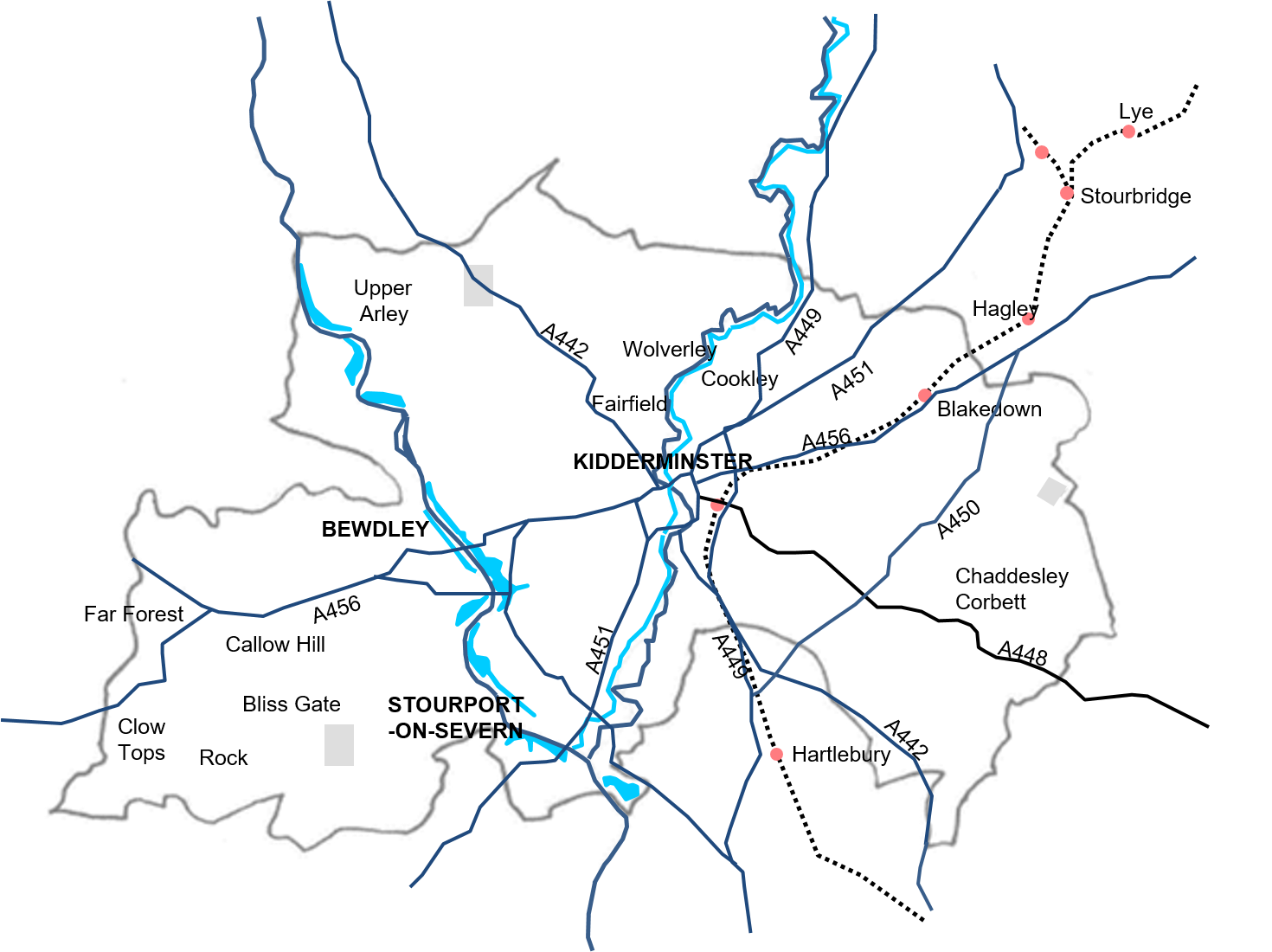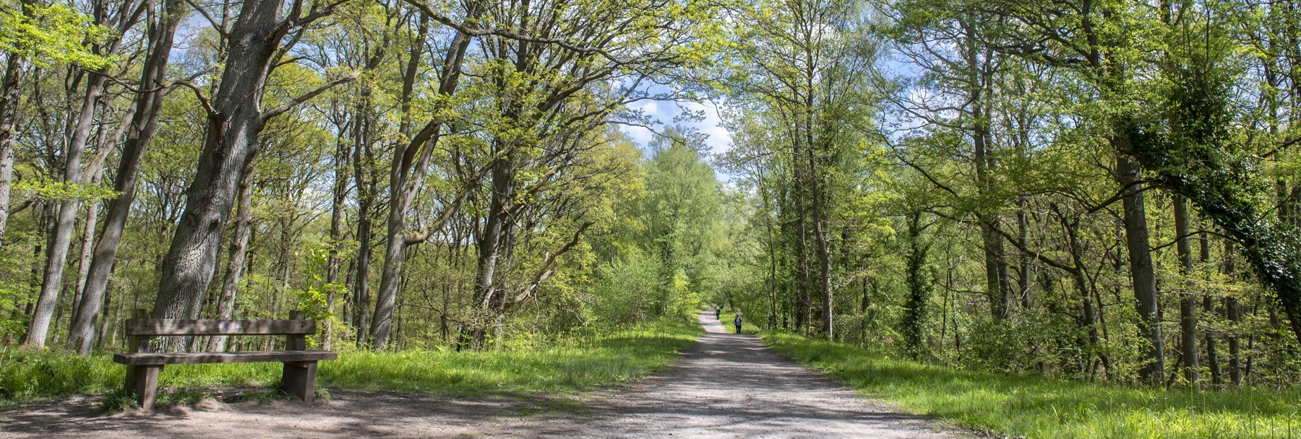Design, amenity and shopfronts supplementary planning document
An Introduction to Wyre Forest
Development within Wyre Forest District
- Pre-war housing development
- Kidderminster Northern expansion e.g., Marlpool and Ferndale
- Bewdley Westward expansion e.g. The Lakes and Hales Park
- Stourport on Severn North of the river, large areas of Burlish and Lickhill were developed for housing in 1960s and 70s
- 1970
- Kidderminster Eastern growth at Offmore Farm plus to south Spennells (up to early 1990s)
- Bewdley Southern expansion at Highclere and Park Dingle and eastward at Sandbourne Drive
- Stourport on Severn North of the river, large areas of Burlish and Lickhill were developed for housing in 1960s and 70s
- 1990
- Recent development
- Kidderminster Recent development – infill on brownfield sites e.g. Stourvale works, Georgian Carpets and British Sugar
- Stourport on Severn Recent development at Timber Lane and on the old PowerStation site, plus along Bewdley Road – brownfield redevelopment
Wyre Forest’s main towns have all seen significant expansion since the end of the war with large suburban estates being built on greenfield sites, especially in the 1950s and 1960s.
Key for images
 Pre – War housing development
Pre – War housing development 1946 – 1970 housing development
1946 – 1970 housing development 1971 – 1990 housing development
1971 – 1990 housing development Post 1990 housing development
Post 1990 housing development

Areas of settlement
Wyre Forest in Context:
Wyre Forest District is situated within the North of Worcestershire. Covering 75 sq. miles, it has a population of approximately 101,600 (2021) based on the 2021 census Office for National Statistics (ONS). The District comprises of three towns- Kidderminster, Stourport on Severn and Bewdley, together with a rural
hinterland which includes several small villages. The three towns form a triangle of settlements at the centre of the District separated by narrow areas of open countryside. Despite their proximity, each has its own character and community identity.
The three main towns; Kidderminster, Stourport on Severn and Bewdley:
Kidderminster (census 2021 pop. 57,400) is the main centre for commerce. It
developed rapidly in the 19th Century with the expansion of the carpet industry to become a world leading centre for carpet production. Since the 1970s the town’s carpet industry has been in decline and a gradual process of economic diversification has taken place.
Stourport on Severn (census 2021 pop. 20,653) developed as an important industrial Georgian Canal Town at the confluence of the Staffordshire & Worcestershire Canal and the River Severn. For over 100 years this attractive town with its riverside
meadows has been a popular day trip destination for residents from Birmingham and the Black Country.
Bewdley ( census 2021 pop. 8,287) is a Georgian riverside town, which saw significant development during the 1960s. Today Bewdley is an attractive historic market town and a popular visitor destination.
Rural Settlements:
The District’s rural settlements surround the 3 main towns. To the east, the larger, generally, more accessible settlements include Chaddesley Corbett, Blakedown, Cookley, Fairfield and Wolverley. Whilst to the West of the River Severn the smaller settlements of Clows Top, Far Forest, Callow Hill, Bliss Gate and Rock provide limited services to rural residents. The rural areas are influenced by the adjacent conurbation in terms of attractiveness for commuting and house prices here are generally high.

Heritage and Local Distinctiveness
The heritage of an area brings with it challenges. Proposals need to respond to the setting of heritage assets, whether specific or area based. This can include statutory assets such as conservation areas, listed buildings and archaeological designations, but also locally important assets.
The heritage of the area can help inform new development, but this does not mean a literal interpretation through pastiche development.
Conservation areas:
There are 17 Conservation Areas within the district, one covers much of Bewdley town centre, 4 in Stourport-on-Severn, 4 in Kidderminster, 7 in rural settlements and a linear one covering the Staffordshire and Worcestershire Canal. Character Appraisals for these Conservation Areas are available on the website.
Listed and locally listed buildings:
There are over 650 listed buildings within the Wyre Forest, as defined by Historic England. Please refer to the Historic England website (Search the List - Find listed buildings, monuments, battlefields and more | Historic England) for more information.
Carpet and Music Heritage:
Kidderminster is best known for its carpet manufacturing industry which started around 1735 and became world famous for its quality. The carpet industry was the town’s main employer with over 20,000 workers, until its gradual decline in the 1970s.
Kidderminster however has another strong cultural past as a major musical hub of the 60s and 70s with the Town Hall and Frank Freeman’s Dance Hall playing host to major up and coming bands, boasting an impressive line-up including Captain Beefheart, Manfred Mann and Led Zeppelin's front man Robert Plant.
Whilst Kidderminster benefits from major new developments, its industrial heritage should not be forgotten. Some of the Carpet factory buildings are listed and have been brought back into alternative uses and the Museum of Carpet provides an educational day out for anyone interested in how it all began. It’s also important to ensure the rich musical heritage is not lost and future generations can appreciate how Kidderminster has contributed to musical history. Along with Kidderminster’s evolving identity an arts and music heritage will entwine the past, present and future, promoting the reuse of key buildings and enriching the fabric of the public realm in a dynamic multi-media explosion.
Conservation Areas within Wyre Forest
Conservation Areas within Stourport- on -Severn
- Areley Kings
- Gilgal
- Stourport-on-Severn 1
- Stourport-on-Severn 2
Conservation Areas within Kidderminster
- Blakebrook
- Church Street
- Green Street
- Vicar Street
Other Conservation Areas
- Bewdley
- Broome
- Chaddesley Corbett
- Churchill
- Harvington
- Ribbesford
- Wolverly
- The Staffordshire and Worcestershire Canal


Key Issues
Health and Environmental:
The design of the built environment can have a significant impact on both physical and mental wellbeing. Well-designed built environment can help to reduce health inequalities in Wyre Forest; while poor environmental quality, housing conditions or pollution can exacerbate them
Planning will investigate ‘designing in health’ into our environments to promote and encourage physical exercise and psychological wellbeing and improve cognitive functioning.
This can include the overall quality of public spaces, from street layouts and connectivity, green infrastructure/ landscaping, and traffic calming measures, to a person's interaction with the surrounding cultural and historic environment. The quality of the public realm is vitally important for both mental and physical health.
Social:
Design has a direct effect on the society in which we live in. From how it makes people feel, to making our lives better and easier. Well-designed spaces mean that spaces are safe and inclusive, are built to a good quality and are sustainable, which increases the urban vitality.
Economic:
When good design is prominent, it can have a direct impact on the overall commercial property value. Well designed places generally will have a greater economic value. From a public realm perspective, consumers are more likely to be enticed into spending when an area is fit for purpose and designed well.
The district’s assets are fundamental to the character of the district,but within the asset themes are embedded difficulties which speak to the diversity and differences that are found across the District
There are tensions and inequalities that exist within the district that new development should help to address, including the quality of and access to green space, areas of multiple deprivation, access to public transport, barriers, walking and cycling, as well as an incremental erosion of character through alterations to buildings or the street scene. This Design SPD draws upon on these elements as a basis for directing future growth in a way that is context-led and sustainable.
Natural assets
Improving access to green spaces will contribute to improved health levels, with increased physical activity and active travel. This would further help improve disparities in outcomes in health in Wyre Forest.
History and heritage
Whilst there are 17 Conservation Areas, some of those see limited investment
or management. The limited designations combined with financial and viability disparities mean there are inequalities of quality of design within the conservation areas.
Diverse communities
Wyre Forest District has a diverse community. Health statistics reveal real disparities across the district – with the highest deprivation rates falling within Birchen Coppice, Stourport, Areley Kings and Kidderminster Town (Census, 2021). These nuances and diversity in character must underpin future change and investment to ensure it brings greatest benefit.
Permeability
Car travel had been replacing short journeys for decades as it can be seen as more convenient, and people now tend to travel longer distances. This has been a trend for 40 years and is connected to a decline in physical activity.
This decline in physical activity is a factor in health outcomes for Wyre Forest residents. Life expectancy is 8.4 years lower for men and 11.7 years lower for women in the most deprived areas of Wyre Forest than in the least deprived areas (Wyre Forest Health Profile Nov 2019). Therefore, it will be imperative for all new developments to achieve maximum permeability and connectivity through sites that promotes sustainable and active modes of travel.
Summary of Social, Economic and Environmental Aspects of Sustainable Development within Wyre Forest
Social
- Urban vitality
- Place quality
- Inclusivity
Health and Environmental
- Walkability and active travel
- Greenness and physical health
- Urban form and energy use
Economic
- Property values and green space
- Public Realm
- Public spending
- Commercial property values
The previous pages explored the character of Wyre Forest and showcased some of the assets that Wyre Forest has to offer. Some of the key ones that help to encapsulate Wyre Forest’s distinctiveness include:
Natural assets
Wyre Forest’s waterways and green spaces provide spots for rest and recreation, as well as supporting a diverse ecological network and Sustainable Urban Drainage Systems (SUDs). There is an opportunity to restore and improve access to green spaces and along waters, to re-wild and help nature recovery to take its course through connecting green spaces, and for any new riverside development to contribute positively to its setting
History and heritage assets
There is an opportunity to properly appreciate what already exists in Wyre Forest. Re-purposing underused buildings or taking cues from the area’s past to inform the design of new high-quality development. More broadly, there is an opportunity to conserve and enhance historic areas through targeted intervention.
Local distinctiveness
There are three thriving towns with their own distinctive identity. Kidderminster benefits from extensive brownfield sites presenting opportunities including for canal and riverside regeneration. Stourport-on-Severn riverside and the historic canal basins have been fully restored and attract high visitor numbers; Bewdley's flourishing riverside environment offers many opportunities for visitors. The local distinctiveness should be used as a starting point for any future growth.
All new developments should take opportunities to integrate existing and new green infrastructure from the outset.



Let us know your comments
We welcome your comments and feedback. Consultations runs until 5pm Wednesday 8 May 2024.


